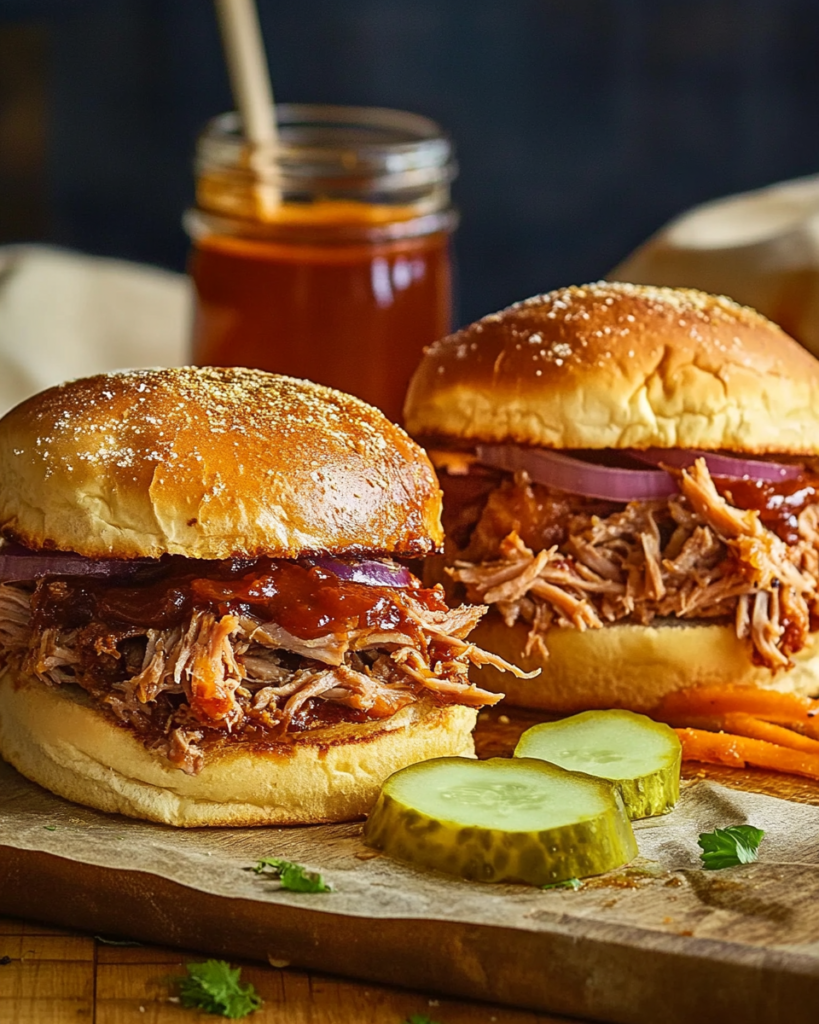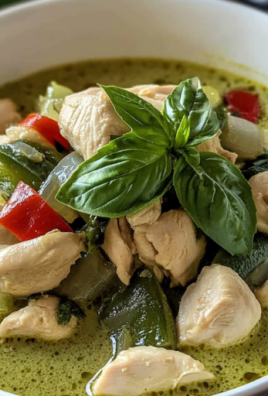
BBQ Pulled Pork Sandwiches are an iconic dish in American cuisine, known for their tender, smoky, and flavorful meat served on soft buns and topped with a variety of sauces and garnishes. This classic comfort food embodies the essence of barbecue culture, offering a perfect blend of smoky, tangy, and slightly sweet flavors. Pulled pork sandwiches are a staple at family gatherings, cookouts, food festivals, and barbecue joints, transcending regional boundaries to become a universally loved dish.
The appeal of BBQ pulled pork sandwiches lies not only in their irresistible flavor but also in their versatility. Whether you prefer a tangy vinegar-based sauce, a sweet tomato-based sauce, or a spicy mustard blend, there’s a pulled pork sandwich to suit every palate. This dish represents more than just a meal; it’s a celebration of community, tradition, and the art of barbecue.
Historical Background
Origins of Pulled Pork in Barbecue Traditions
The roots of pulled pork can be traced back to the indigenous peoples of the Caribbean, who cooked meat over open flames using wood and spices. This method, known as “barbacoa,” was later adopted and adapted by European settlers in the Americas. Barbacoa eventually evolved into the barbecue traditions we know today, with each region developing its own unique techniques and flavors.
Pulled pork, specifically, became a hallmark of Southern barbecue. The availability of pork in the South, combined with the practice of slow-cooking tougher cuts of meat to tender perfection, made it an ideal candidate for barbecue. Early pitmasters discovered that low-and-slow cooking methods, such as smoking, broke down the connective tissues in pork, resulting in the juicy, shredded texture that defines pulled pork.
The Rise of the Pulled Pork Sandwich
The pulled pork sandwich emerged as a convenient way to enjoy barbecue on the go. The combination of tender, flavorful meat and soft, pillowy bread made it an instant hit. Over time, regional barbecue styles influenced the sandwich, with different sauces, rubs, and toppings adding unique twists. Today, pulled pork sandwiches are a staple of both casual diners and upscale barbecue restaurants, beloved for their satisfying simplicity and adaptability.
Regional Variations
One of the most fascinating aspects of BBQ pulled pork sandwiches is the regional diversity in their preparation and flavor profiles. Each barbecue tradition brings its own spin to the dish, creating distinct variations that reflect the culinary heritage of the region.
Carolina-Style Pulled Pork
- Eastern Carolina: Known for its tangy, vinegar-based sauce seasoned with red pepper flakes. Eastern Carolina pulled pork highlights the natural flavor of the meat, allowing the tangy sauce to complement rather than overpower.
- Western Carolina (Lexington Style): Features a slightly sweeter vinegar-based sauce with the addition of ketchup. This style often includes a red slaw as a topping, which adds a crunchy texture and extra tanginess.
Memphis-Style Pulled Pork
- Memphis barbecue is famous for its dry rubs, which are generously applied to the pork before cooking. The pulled pork is typically served with a tomato-based barbecue sauce on the side, allowing diners to add as much or as little sauce as they prefer.
Kansas City-Style Pulled Pork
- Kansas City barbecue is characterized by its sweet and tangy tomato-based sauces, which often include molasses or brown sugar. Pulled pork sandwiches from this region are typically served with a generous helping of sauce and topped with pickles or coleslaw.
Texas-Style Pulled Pork
- While Texas barbecue is known for its focus on beef, pulled pork sandwiches in Texas often feature bold, smoky flavors with a hint of spice. The pork is typically smoked over mesquite or oak wood and served with a tangy, peppery barbecue sauce.
Alabama-Style Pulled Pork
- Alabama’s unique contribution to barbecue is its white sauce, a tangy, mayonnaise-based condiment that adds a creamy element to pulled pork sandwiches. This style is less common but highly distinctive, offering a delicious alternative to traditional tomato or vinegar-based sauces.
Cultural Significance
BBQ pulled pork sandwiches hold a special place in American culture, symbolizing the spirit of community, hospitality, and culinary creativity.
A Dish for Gatherings
Pulled pork sandwiches are often the centerpiece of social events, from backyard barbecues to church picnics and food festivals. Their ability to feed a crowd makes them a popular choice for communal dining, bringing people together over a shared love of good food.
Representation of Regional Identity
In the United States, barbecue is more than just a cooking method—it’s a cultural identity. Pulled pork sandwiches reflect the pride and traditions of regional barbecue styles, showcasing the unique flavors and techniques that define each area.
Influence on Modern Cuisine
In recent years, BBQ pulled pork sandwiches have transcended traditional barbecue joints to appear on menus at gastropubs, food trucks, and fine dining establishments. Chefs have embraced the versatility of pulled pork, incorporating it into fusion dishes and experimenting with unconventional toppings and sauces.
Ingredients, Preparation, and Cooking Techniques
The success of BBQ Pulled Pork Sandwiches lies in the quality of ingredients and the mastery of preparation and cooking techniques. Whether you’re a seasoned pitmaster or a home cook, understanding each step ensures tender, flavorful pulled pork that pairs perfectly with soft buns, tangy sauces, and complementary toppings.
Selecting the Right Cut of Pork
Pulled pork relies on choosing the right cut of meat, as the connective tissues and fat content play a crucial role in achieving its signature tenderness and juiciness.
Pork Shoulder (Boston Butt)
- Why It’s Ideal: Pork shoulder, specifically the Boston butt portion, is the most common cut for pulled pork. Its marbling and collagen content break down during slow cooking, resulting in tender, shreddable meat.
- Bone-In vs. Boneless: Bone-in cuts are preferred for flavor and moisture retention, though boneless options are more convenient for slicing and shredding.
Pork Picnic Shoulder
- Slightly leaner than the Boston butt, the picnic shoulder includes skin that crisps beautifully during cooking, adding a unique texture.
Alternatives
- Pork loin or tenderloin can be used for a leaner option, but they require careful monitoring to prevent dryness. These cuts lack the fat and collagen needed for traditional pulled pork.
Marinades, Rubs, and Seasonings
Seasoning the pork is the first step in building flavor. The choice of marinades, dry rubs, and brines impacts the final taste profile.
Dry Rubs
Dry rubs are a traditional and effective way to flavor the pork before cooking. A balanced rub combines sweet, spicy, and savory elements:
- Key Ingredients:
- Brown sugar for sweetness and caramelization
- Paprika (regular or smoked) for depth
- Garlic powder, onion powder, and ground mustard for savory notes
- Cayenne or chili powder for heat (optional)
- Application Tips:
- Coat the pork generously with the rub, ensuring even coverage. Allow it to rest for at least 2 hours or overnight for deeper flavor penetration.
Wet Marinades
Marinades add moisture and infuse the pork with complementary flavors.
- Ingredients: A mix of apple cider vinegar, Worcestershire sauce, soy sauce, olive oil, and spices.
- Marination Time: Allow the pork to marinate for 4–8 hours in the refrigerator.
Brines
Brining enhances moisture retention and tenderness, particularly for leaner cuts.
- Basic Brine Recipe: Dissolve 1/4 cup salt and 1/4 cup sugar in 1 quart of water. Add herbs, garlic, and spices for flavor.
- Timing: Brine for 8–12 hours in the refrigerator.
Cooking Methods
The hallmark of perfect pulled pork is the low-and-slow cooking process, which allows the meat to become tender and flavorful. Below are detailed steps for various cooking methods.
Smoking
Smoking is the traditional method for preparing pulled pork, infusing it with deep, smoky flavors.
- Preparation
- Preheat the smoker to 225°F (107°C). Use hardwoods like hickory, applewood, or oak for optimal flavor.
- Cooking Process
- Place the seasoned pork shoulder directly on the smoker grates, fat side up.
- Smoke for 6–8 hours, or until the internal temperature reaches 165°F (74°C). Wrap the pork in aluminum foil or butcher paper to retain moisture and continue smoking until it reaches 200°F–205°F (93°C–96°C).
- Resting
- Let the pork rest for 30–60 minutes before shredding. This step allows the juices to redistribute.
Slow Cooker
The slow cooker is a convenient option for achieving tender pulled pork with minimal effort.
- Preparation
- Place the seasoned pork in the slow cooker. Add 1 cup of liquid (apple cider, broth, or barbecue sauce) to create a moist cooking environment.
- Cooking Process
- Cook on low for 8–10 hours or on high for 4–6 hours. The pork should easily shred with a fork when done.
Oven-Baked Pulled Pork
Oven baking is a versatile method that requires only basic kitchen equipment.
- Preparation
- Preheat the oven to 300°F (150°C). Place the pork shoulder in a roasting pan or Dutch oven.
- Add liquid to the pan (e.g., apple cider or broth) and cover tightly with a lid or aluminum foil.
- Cooking Process
- Roast for 4–6 hours, basting occasionally, until the pork reaches an internal temperature of 200°F (93°C).
Pressure Cooker (Instant Pot)
For quicker preparation, a pressure cooker achieves tender pulled pork in a fraction of the time.
- Preparation
- Season the pork and sear it directly in the Instant Pot using the sauté function.
- Cooking Process
- Add liquid (e.g., broth or barbecue sauce) and cook on high pressure for 60–90 minutes, depending on the size of the pork shoulder. Allow natural pressure release for 10–15 minutes before opening.
Shredding and Sauce Integration
Shredding the Pork
- Tools: Use two forks, meat claws, or your hands (with heat-resistant gloves) to shred the pork into bite-sized pieces.
- Removing Excess Fat: Discard large chunks of fat while shredding, but retain some for flavor.
Incorporating Sauces
- After shredding, toss the pork with your sauce of choice to coat it evenly. Allow the pork to absorb the sauce for 10–15 minutes before serving.
Types of BBQ Sauces
- Vinegar-Based Sauce: Tangy and light, perfect for Carolina-style sandwiches.
- Tomato-Based Sauce: Sweet and smoky, common in Kansas City-style sandwiches.
- Mustard-Based Sauce: Bold and tangy, a South Carolina specialty.
- White Sauce: Creamy and tangy, unique to Alabama barbecue.
Assembling the Sandwich
The final step in creating the perfect BBQ Pulled Pork Sandwich is assembly. Each element contributes to the overall texture, flavor, and presentation.
Choosing the Right Bun
- Brioche Buns: Soft and slightly sweet, they complement the richness of pulled pork.
- Potato Rolls: Sturdy and flavorful, ideal for holding up to saucy fillings.
- Pretzel Buns: Provide a chewy texture and a hint of saltiness.
- Gluten-Free Options: Use gluten-free buns or lettuce wraps for dietary needs.
Toppings and Condiments
- Coleslaw: Adds crunch and a tangy balance to the smoky pork.
- Pickles: Dill or bread-and-butter pickles provide acidity and brightness.
- Crispy Onions: Add a savory crunch.
- Cheese: Cheddar or smoked gouda enhances the dish with creamy richness.
Layering Tips
- Place a generous portion of pulled pork on the bottom half of the bun.
- Drizzle extra sauce over the pork and add your chosen toppings.
- Finish with the top bun and serve immediately.
Serving Ideas, Creative Variations, and Leftover Transformations
BBQ Pulled Pork Sandwiches are not just a dish—they’re a culinary canvas that invites creativity, customization, and exploration. From innovative variations and thoughtful pairings to ingenious uses for leftovers, this section dives deep into making the most of this iconic comfort food.
Serving Ideas and Presentation
Classic Serving Style
The traditional BBQ Pulled Pork Sandwich is served on a soft bun with a generous heap of pulled pork, a drizzle of barbecue sauce, and classic toppings like coleslaw or pickles. This timeless approach balances flavors and textures for a crowd-pleasing meal.
Family-Style Platters
For large gatherings, serve pulled pork in a large bowl alongside a variety of buns, sauces, and toppings. Guests can build their own sandwiches, customizing each to their liking.
Sliders for Parties
Mini versions of pulled pork sandwiches, served on slider buns, are perfect for parties and appetizers. Arrange sliders on a platter with toothpicks for easy serving.
Gourmet Presentation
For an elevated twist, serve open-faced pulled pork sandwiches on artisan bread or ciabatta rolls. Garnish with microgreens, caramelized onions, or fried shallots for a sophisticated touch.
Creative Variations
International Twists
- Korean BBQ Pulled Pork Sandwich
- Incorporate gochujang (Korean chili paste) into the barbecue sauce for a spicy, umami-rich flavor.
- Top with kimchi for a tangy and crunchy contrast.
- Mexican-Inspired Pulled Pork Torta
- Use telera or bolillo rolls as the base.
- Add guacamole, refried beans, and pickled jalapeños for a bold flavor profile.
- Mediterranean Pulled Pork Pita
- Swap buns for warm pita bread.
- Add tzatziki sauce, fresh cucumber slices, and crumbled feta cheese.
Fusion Creations
- Pulled Pork Bahn Mi
- Serve pulled pork on a baguette with pickled carrots, daikon, cilantro, and a drizzle of spicy mayo.
- Add jalapeño slices for heat.
- Pulled Pork Pizza
- Use barbecue sauce as the base for the pizza. Top with pulled pork, red onions, and mozzarella. Bake until golden and bubbly.
- Pulled Pork Tacos
- Fill soft corn or flour tortillas with pulled pork, shredded lettuce, pico de gallo, and a squeeze of lime.
Vegetarian and Vegan Options
For those seeking plant-based alternatives, the following ideas replicate the flavors and textures of pulled pork sandwiches:
- Jackfruit Pulled “Pork”
- Use young green jackfruit, seasoned with barbecue sauce and spices, as a substitute for pork. Shred the jackfruit to mimic the texture of pulled pork.
- Mushroom Pulled “Pork”
- Shred king oyster mushrooms and roast them with barbecue seasoning for a smoky, tender alternative.
Perfect Pairings
Classic Side Dishes
No BBQ Pulled Pork Sandwich is complete without the right sides. Here are some timeless pairings:
- Coleslaw
- Creamy or vinegar-based coleslaw provides a tangy counterbalance to the rich pulled pork.
- Baked Beans
- Sweet, smoky baked beans complement the savory flavors of the sandwich.
- Potato Salad
- A classic Southern-style potato salad with mustard and pickles enhances the barbecue theme.
- Cornbread
- Serve warm cornbread with butter and honey for a comforting addition.
Lighter Sides
For a fresher take, consider lighter side dishes:
- Grilled Vegetables: Zucchini, bell peppers, and asparagus add a healthy, smoky contrast.
- Cucumber Salad: Crisp cucumbers tossed with dill, vinegar, and a touch of sugar offer refreshing simplicity.
Beverage Pairings
- Craft Beers: A hoppy IPA or a malty amber ale pairs wonderfully with the smoky and tangy notes of pulled pork.
- Sweet Tea: This Southern classic is a non-alcoholic option that balances the flavors beautifully.
- Bourbon Cocktails: Try a classic Old Fashioned or a bourbon lemonade for a sophisticated touch.
Creative Leftover Transformations
Leftover pulled pork is incredibly versatile and can be repurposed into exciting new dishes.
Pulled Pork Nachos
- Layer tortilla chips with pulled pork, shredded cheese, black beans, and jalapeños. Bake until the cheese is melted, then top with sour cream, guacamole, and salsa.
Pulled Pork Quesadillas
- Spread pulled pork and shredded cheese between two tortillas. Cook on a griddle until crispy and golden, then cut into wedges.
Pulled Pork Mac and Cheese
- Stir pulled pork into a creamy mac and cheese for a hearty, indulgent twist.
Pulled Pork Shepherd’s Pie
- Use pulled pork as the base, top with mashed potatoes, and bake until golden and bubbly.
Pulled Pork Breakfast Hash
- Sauté pulled pork with diced potatoes, bell peppers, and onions. Top with a fried egg for a hearty breakfast.
Pulled Pork Spring Rolls
- Wrap pulled pork, shredded cabbage, and carrots in rice paper. Serve with a sweet chili or hoisin dipping sauce.
Pulled Pork Fried Rice
Stir pulled pork into fried rice along with scrambled eggs, vegetables, and soy sauce for an Asian-inspired dish.
Advanced Hosting Tips and Presentation
Buffet-Style Setup
For large gatherings, set up a pulled pork sandwich bar with a variety of buns, sauces, and toppings. Include labels to help guests customize their sandwiches.
Elegant Plating for Formal Events
Serve open-faced pulled pork sandwiches on artisan bread with garnishes like microgreens or edible flowers. Drizzle barbecue sauce artistically around the plate for a refined presentation.
Seasonal Additions
- In summer, pair sandwiches with fresh corn on the cob or watermelon slices.
- In fall, add apple chutney or spiced cranberry sauce as a topping.
Conclusion
BBQ Pulled Pork Sandwiches are a culinary treasure that lends itself to endless creativity and versatility. From traditional presentations to global-inspired variations, there’s no shortage of ways to enjoy this iconic dish. With thoughtful pairings, inventive uses for leftovers, and advanced hosting tips, pulled pork sandwiches can be tailored to suit any occasion, ensuring they remain a beloved staple in any kitchen.
Armed with these ideas and techniques, you’re ready to elevate your BBQ Pulled Pork Sandwiches to new heights of flavor and creativity. Enjoy experimenting, sharing, and savoring every bite!




Leave a Comment